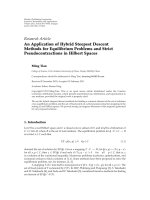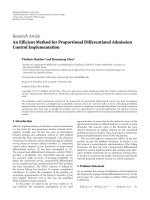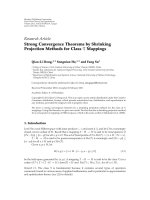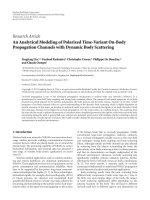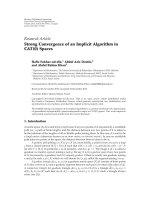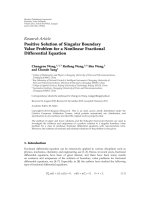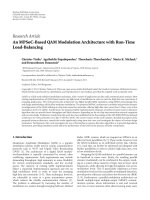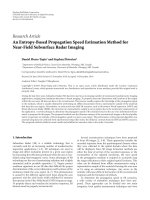Báo cáo hóa học: " Research Article An Application of Hybrid Steepest Descent Methods for Equilibrium Problems and Strict Pseudocontractions in Hilbert Spaces" pdf
Bạn đang xem bản rút gọn của tài liệu. Xem và tải ngay bản đầy đủ của tài liệu tại đây (521.15 KB, 15 trang )
Hindawi Publishing Corporation
Journal of Inequalities and Applications
Volume 2011, Article ID 173430, 15 pages
doi:10.1155/2011/173430
Research Article
An Application of Hybrid Steepest Descent
Methods for Equilibrium Problems and Strict
Pseudocontractions in Hilbert Spaces
Ming Tian
College of Science, Civil Aviation University of China, Tianjin 300300, China
Correspondence should be addressed to Ming Tian,
Received 9 December 2010; Accepted 13 February 2011
Academic Editor: Shusen Ding
Copyright q 2011 Ming Tian. This is an open access article distributed under the Creative
Commons Attribution License, which permits unrestricted use, distribution, and reproduction in
any medium, provided the original work is properly cited.
We use the hybrid steepest descent methods for finding a common element of the set of solutions
of an equilibrium problem and the set of fixed points of a strict pseudocontraction mapping in the
setting of real Hilbert spaces. We proved strong convergence theorems of the sequence generated
by our proposed schemes.
1. Introduction
Let H be a real Hilbert space and C a closed convex subset of H, and let φ be a bifunction of
C × C into R, where R is the set of real numbers. The equilibrium problem for φ : C × C → R
is to find x ∈ C such that
EP : φ x, y ≥ 0
∀y ∈ C
1.1
denoted the set of solution by EP φ . Given a mapping T : C → H, let φ x, y
Tx, y − x
for all x, y ∈ C, then z ∈ EP φ if and only if Tz, y − z ≥ 0 for all y ∈ C, that is, z
is a solution of the variational inequality. Numerous problems in physics, optimizations, and
economics reduce to find a solution of 1.1 . Some methods have been proposed to solve the
equilibrium problem, see, for instance, 1, 2 .
A mapping T of C into itself is nonexpansive if Tx−Ty ≤ x−y , for all x, y ∈ C. The
set of fixed points of T is denoted by F T . In 2007, Plubtieng and Punpaeng 3 , S. Takahashi
and W. Takahashi 4 , and Tada and W. Takahashi 5 considered iterative methods for finding
an element of EP φ ∩ F T .
2
Journal of Inequalities and Applications
Recall that an operator A is strongly positive if there exists a constant γ > 0 with the
property
Ax, x ≥ γ x 2 ,
∀x ∈ H.
1.2
In 2006, Marino and Xu 6 introduced the general iterative method and proved that
for a given x0 ∈ H, the sequence {xn } is generated by the algorithm
xn
1
αn γ f xn
I − αn A Txn ,
n ≥ 0,
1.3
where T is a self-nonexpansive mapping on H, f is a contraction of H into itself with β ∈ 0, 1
and {αn } ⊂ 0, 1 satisfies certain conditions, and A is a strongly positive bounded linear
operator on H and converges strongly to a fixed-point x∗ of T which is the unique solution
to the following variational inequality:
γ f − A x∗ , x − x∗ ≤ 0, for x ∈ F T , and is also the optimality condition for some
minimization problem. A mapping S : C → H is said to be k-strictly pseudocontractive if
there exists a constant k ∈ 0, 1 such that
Sx − Sy
2
≤ x−y
2
k
I−S x− I−S y
2
,
∀x, y ∈ C.
1.4
Note that the class of k-strict pseudo-contraction strictly includes the class of nonexpansive mapping, that is, S is nonexpansive if and only if S is 0-srictly pseudocontractive; it
is also said to be pseudocontractive if k 1. Clearly, the class of k-strict pseudo-contractions
falls into the one between classes of nonexpansive mappings and pseudo-contractions.
The set of fixed points of S is denoted by F S . Very recently, by using the general
approximation method, Qin et al. 7 obtained a strong convergence theorem for finding an
element of F S . On the other hand, Ceng et al. 8 proposed an iterative scheme for finding
an element of EP φ ∩ F S and then obtained some weak and strong convergence theorems.
Based on the above work, Y. Liu 9 introduced two iteration schemes by the general iterative
method for finding an element of EP φ ∩ F S .
In 2001, Yamada 10 introduced the following hybrid iterative method for solving the
variational inequality:
xn
1
Txn − μλn F Txn ,
n ≥ 0,
1.5
where F is k-Lipschitzian and η-strongly monotone operator with k > 0, η > 0, 0 < μ < 2η/k2 ,
then he proved that if {λn } satisfyies appropriate conditions, the {xn } generated by 1.5
converges strongly to the unique solution of variational inequality
F x, x − x ≥ 0,
∀x ∈ Fix T ,
x ∈ Fix T .
1.6
Motivated and inspired by these facts, in this paper, we introduced two iteration methods by
the hybrid iterative method for finding an element of EP φ ∩ F S , where S : C → H is
a k-strictly pseudocontractive non-self mapping, and then obtained two strong convergence
theorems.
Journal of Inequalities and Applications
3
2. Preliminaries
Throughout this paper, we always assume that C is a nonempty closed convex subset of a
x to indicate that the sequence {xn } converges weakly to
Hilbert space H. We write xn
x. xn → x implies that {xn } converges strongly to x. For any x ∈ H, there exists a unique
nearest point in C, denoted by PC x, such that
x − PC x ≤ x − y ,
∀y ∈ C.
2.1
Such a PC x is called the metric projection of H onto C. It is known that PC is nonexpansive.
Furthermore, for x ∈ H and u ∈ C, u pc x, ⇔ x − u, u − y ≥ 0, for all y ∈ C.
It is widely known that H satisfies Opial’s condition 11 , that is, for any sequence
{xn } with xn
x, the inequality
lim inf xn − x < lim inf xn − y ,
n→∞
n→∞
2.2
holds for every y ∈ H with y / x. In order to solve the equilibrium problem for a bifunction
φ : C × C → R, let us assume that φ satisfies the following conditions:
A1 φ x, x
0, for all x ∈ C,
A2 φ is monotone, that is, φ x, y
φ y, x ≤ 0, for all x, y ∈ C,
A3 For all x, y, z ∈ C.
limφ tz
t↓0
1 − t x, y ≤ φ x, y ;
2.3
A4 For each fixed x ∈ C, the function y → φ x, y is convex and lower semicontinuous.
Let us recall the following lemmas which will be useful for our paper.
Lemma 2.1 see 12 . Let φ be a bifunction from C × C into R satisfying (A1), (A2),(A3) and (A4)
then, for any r > 0 and x ∈ H, there exists z ∈ C such that
1
y − z, z − x ≥ 0,
r
φ z, y
Further, if Tr x
{z ∈ C : φ z, y
∀y ∈ C.
2.4
1/r y − z, z − x ≥ 0, ∀y ∈ C}, then the following hold:
1 Tr is single-valued,
2 Tr is firmly nonexpansive, that is,
Tr x − Tr y
3 F Tr
2
≤ Tr x − Tr y, x − y ,
EP φ ,
4 EP φ is nonempty, closed and convex.
∀x, y ∈ H;
2.5
4
Journal of Inequalities and Applications
Lemma 2.2 see 13 . If S : C → H is a k-strict pseudo-contraction, then the fixed-point set F S
is closed convex, so that the projection PF S is well difened.
Lemma 2.3 see 14 . Let S : C → H be a k-strict pseudo-contraction. Define T : C → H by
Tx
λx
1 − λ Sx for each x ∈ C, then, as λ ∈ k, 1 , T is nonexpansive mapping such that
F T
F S.
Lemma 2.4 see 15 . In a Hilbert space H, there holds the inequality
x
y
2
≤ x
2
2 y, x
y ,
∀x, y ∈ H.
2.6
Lemma 2.5 see 16 . Assume that {an } is a sequence of nonnegative real numbers such that
an
1
≤ 1 − γn an
γ n δn ,
n ≥ 0,
2.7
where {γn } is a sequence in (0,1) and {δn } is a sequence in Ê, such that
i
∞
n 1 γn
∞,
ii lim supn → ∞ δn ≤ 0 or
Then limn → ∞ an 0.
∞
n 1
|δn γn | < ∞.
3. Main Results
Throughout the rest of this paper, we always assume that F is a L-lipschitzian continuous and
η-strongly monotone operator with L, η > 0 and assume that 0 < μ < 2η/L2 . τ μ η − μL2 /2 .
Let {Tλn } be mappings defined as Lemma 2.1. Define a mapping Sn : C → H by Sn x
βn x 1 − βn Sx, for all x ∈ C, where βn ∈ k, 1 , then, by Lemma 2.3, Sn is nonexpansive. We
consider the mapping Gn on H defined by
Gn x
I − αn μF Sn Tλn x,
x ∈ H,
n ∈ N,
3.1
where αn ∈ 0, 1 . By Lemmas 2.1 and 2.3, we have
Gn x − Gn y ≤ 1 − αn τ
≤ 1 − αn τ
Tλn x − Tλn y
x−y .
3.2
It is easy to see that Gn is a contraction. Therefore, by the Banach contraction principle,
F
Gn has a unique fixed-point xn ∈ H such that
F
xn
F
I − αn μF Sn Tλn xn .
3.3
Journal of Inequalities and Applications
5
F
For simplicity, we will write xn for xn provided no confusion occurs. Next, we prove
that the sequence {xn } converges strongly to a q ∈ F S ∩ EP φ which solves the variational
inequality
Fq, p − q ≥ 0,
Equivalently, q
PF
∀p ∈ F S ∩ EP φ .
3.4
I − μF q.
S ∩EP φ
Theorem 3.1. Let C be a nonempty closed convex subset of a real Hilbert space H and φ a
bifunction from C × C into R satisfying (A1), (A2), (A3), and (A4). Let S : C → H be a kstrictly pseudocontractive nonself mapping such that F S ∩ EP φ / φ. Let F : H → H be an
L-Lipschitzian continuous and η-strongly monotone operator on H with L, η > 0 and 0 < μ < 2η/L2 ,
τ μ η − μL2 /2 . Let {xn } be asequence generated by
φ un , y
1
y − un , un − xn ≥ 0, ∀y ∈ C,
λn
1 − βn Sun ,
yn βn un
xn
I − αn μF yn , ∀n ∈ N,
3.5
where un
Tλn xn , yn
Sn un , and {λn } ⊂ 0, ∞ satisfy lim infn → ∞ λn > 0 if {αn } and {βn }
satisfy the following conditions:
i {αn } ⊂ 0, 1 , limn → ∞ αn
0,
ii 0 ≤ k ≤ βn ≤ λ < 1 and limn → ∞ βn
λ,
then {xn } converges strongly to a point q ∈ F S ∩ EP φ which solves the variational inequality
3.4 .
Proof. First, take p ∈ F S ∩ EP φ . Since un
n ∈ N, we have
un − p
Then, since Sn p
Tλn xn and p
Tλn p, from Lemma 2.1, for any
Tλn xn − Tλn p ≤ xn − p .
3.6
p, we obtain that
yn − p
Sn un − Sn p ≤ un − p ≤ xn − p .
3.7
Further, we have
xn − p
−αn μFp
≤ αn −μF p
It follows that xn − p ≤ μF p /τ.
I − μαn F yn − I − μαn F p
1 − αn τ
yn − p .
3.8
6
Journal of Inequalities and Applications
Hence, {xn } is bounded, and we also obtain that {un } and {yn } are bounded. Notice
that
un − yn ≤ un − xn
xn − yn
3.9
αn −μFyn .
un − xn
By Lemma 2.1, we have
un − p
2
Tλn xn − Tλn p
1
2
2
2
xn − p
≤ xn − p, un − p
un − p
2
3.10
− un − xn
2
.
It follows that
un − p
2
≤ xn − p
2
− xn − un 2 .
3.11
Thus, from Lemma 2.4, 3.7 , and 3.11 , we obtain that
xn − p
2
αn −μFp
I − μαn F yn − I − μαn F p
≤ 1 − αn τ
2
yn − p
2
2αn −μFp, xn − p
≤ 1 − αn τ
2
un − p
2
2αn −μFp, xn − p
≤ 1 − αn τ
2
2
xn − p
1 − 2αn τ
αn τ
− 1 − αn τ
≤ xn − p
2
2
2
2
2
2
2
2αn −μFp
xn − p
2
xn − p
xn − un
αn τ
− xn − un
2αn − μFp xn − p
xn − p
2
− 1 − αn τ
2
xn − un
2
2αn −μFp
xn − p .
3.12
It follows that
1 − αn τ
2
xn − un
2
≤ αn τ
2
xn − p
2
2αn μFp
xn − p .
3.13
Since αn → 0, therefore
lim xn − un
0.
3.14
lim un − yn
0.
3.15
n→∞
From 3.9 , we derive that
n→∞
Journal of Inequalities and Applications
Define T : C → H by Tx
by Lemma 2.3. We note that
7
λx
1 − λ Sx, then T is nonexpansive with F T
yn − un ≤ λ − βn un − Sun
Tun − un ≤ Tun − yn
yn − un .
F S
3.16
So by 3.15 and βn → λ, we obtain that
lim Tun − un
0.
n→∞
3.17
Since {un } is bounded, so there exists a subsequence {uni } which converges weakly to
q. Next, we show that q ∈ F S ∩ EP φ . Since C is closed and convex, C is weakly closed. So
q and q / Tq, it
we have q ∈ C. Let us show that q ∈ F S . Assume that q ∈ F T , Since uni
follows from the Opial’s condition that
lim inf uni − q < lim inf uni − Tq
n→∞
n→∞
≤ lim inf uni − Tuni
n→∞
Tuni − Tq
3.18
≤ lim inf uni − q .
n→∞
This is a contradiction. So, we get q ∈ F T and q ∈ F S .
Next, we show that q ∈ EP φ . Since un Tλn xn , for any y ∈ C, we obtain
φ un , y
1
y − un , un − xn ≥ 0.
λn
3.19
From A2 , we have
1
y − un , un − xn ≥ φ y, un .
λn
3.20
Replacing n by ni , we have
y − uni ,
uni − xni
λni
≥ φ y, uni .
3.21
Since uni − xni /λni → 0 and uni
q, it follows from A4 that 0 ≥ φ y, q , for all
ty
1 − t q for all t ∈ 0, 1 and y ∈ C, then we have zt ∈ C and hence
y ∈ C. Let zt
φ zt , q ≤ 0. Thus, from A1 and A4 , we have
0
φ zt , zt ≤ tφ zt , y
1 − t φ zt , q ≤ tφ zt , y ,
3.22
8
Journal of Inequalities and Applications
and hence 0 ≤ φ zt , y . From A3 , we have 0 ≤ φ q, y for all y ∈ C and hence q ∈ EP φ .
Therefore, q ∈ F S ∩ EP φ . On the other hand, we note that
xn − q
−αn μFq
I − μαn F yn − I − μαn F q.
3.23
Hence, we obtain
2
xn − q
−αn μFq, xn − q
I − μαn F yn − I − μαn F q, xn − q
≤ αn −μFq, xn − q
1 − αn τ
xn − q
2
.
3.24
It follows that
xn − q
2
≤
1
−μFq, xn − q .
τ
3.25
This implies that
xn − q
2
≤
−μFq, xn − q
.
τ
3.26
xni − q
2
≤
−μFq, xni − q
.
τ
3.27
In particular,
Since xni
q, it follows from 3.27 that xni → q as i → ∞. Next, we show that q
solves the variational inequality 3.4 .
As a matter of fact, we have
xn
I − αn μF yn
3.28
I − αn μF Sn Tλn xn ,
and we have
μFxn
−
1
αn
I − Sn Tλn xn − μαn Fxn − FSn Tλn xn .
3.29
Hence, for p ∈ F S ∩ EP φ ,
μF xn , xn − p
−
1
αn
−
1
αn
I − Sn Tλn xn − μαn Fxn − FSn Tλn xn , xn − p
I − Sn Tλn xn − I − Sn Tλn p, xn − p
μ Fxn − FSn Tλn xn , xn − p .
3.30
Journal of Inequalities and Applications
9
Since I − Sn Tλn is monotone i.e., x − y, I − Sn Tλn x − I − Sn Tλn y ≥ 0, for all x, y ∈ H. This
is due to the nonexpansivity of Sn Tλn .
Now replacing n in 3.30 with ni and letting i → ∞, we obtain
μF q, q − p
lim μFxni , xni − p
i→∞
≤ lim μ Fxni − FSn Tλn xni , xni − p
i→∞
3.31
0.
That is, q ∈ F S ∩EP φ is a solution of 3.4 . To show that the sequence {xn } converges
strongly to q, we assume that xnk → x. Similiary to the proof above, we derive x ∈ F S ∩
EP φ . Moreover, it follows from the inequality 3.31 that
μF q, q − x ≤ 0.
3.32
μF x, x − q ≤ 0.
3.33
Interchange q and x to obtain
Adding up 3.32 and 3.33 yields
μη
Hence, q
q−x
2
≤ q − x, μF q − μF x ≤ 0.
3.34
x, and therefore xn → q as n → ∞,
I − μF q − q, q − p ≥ 0, ∀p ∈ F S ∩ EP φ .
3.35
This is equivalent to the fixed-point equation
PF
S ∩EP φ
I − μF q
q.
3.36
Theorem 3.2. Let C be a nonempty closed convex subset of a real Hilbert space H and φ a bifunction
from C × C into R satisfying (A1), (A2), (A3) and (A4). Let S : C → H be a k-strictly
pseudocontractive nonself mapping such that F S ∩EP φ / φ. Let F : H → H be an L-Lipschitzian
continuous and η-strongly monotone operator on H with L, η > 0. Suppose that 0 < μ < 2η/L2 ,
τ μ η − μL2 /2 . Let {xn } and {un } be sequences generated by x1 ∈ H and
φ un , y
xn
1
y − un , un − xn ≥ 0,
λn
1 − βn Sun ,
yn βn un
1
I − αn μF yn ,
∀y ∈ C,
∀n ∈ N,
3.37
10
Journal of Inequalities and Applications
where un
Tλn xn , yn
Sn un if {αn },{βn }, and {λn } satisfy the following conditions:
i {αn } ⊂ 0, 1 , limn → ∞ αn
∞
n 1
0,
αn
ii 0 ≤ k ≤ βn ≤ λ < 1 and limn → ∞ βn
∞
n 1
λ,
∞
n 1
iii {λn } ∈ 0, ∞ , limn → ∞ λn > 0 and
∞
n 1
∞,
|βn
|λn
1
1
|αn
1
− αn | < ∞,
− βn | < ∞,
− λn | < ∞,
then {xn } and {un } converge strongly to a point q ∈ F S ∩EP φ which solves the variational
inequality 3.4 .
Proof. We first show that {xn } is bounded. Indeed, pick any p ∈ F S ∩ EP φ to derive that
xn
1
−p
−αn μFp
I − μαn F yn − I − μαn F p
≤ αn −μF p
≤ 1 − αn τ
1 − αn τ
xn − p
xn − p
αn −μF p
3.38
.
By induction, we have
xn − p ≤ max
x1 − p ,
1
− μF p
τ
,
∀n ∈ N,
3.39
and hence {xn } is bounded. From 3.6 and 3.7 , we also derive that {un } and {yn } are
bounded. Next, we show that xn 1 − xn → 0. We have
xn
1
− xn
I − αn μF yn − I − αn−1 μF yn−1
I − αn μF yn − I − αn μF yn−1
I − αn μF yn−1 − I − αn−1 μF yn−1
≤ 1 − αn τ
yn − yn−1
|αn − αn−1 | μFyn−1
≤ 1 − αn τ
yn − yn−1
K|αn − αn−1 |,
3.40
where
K
sup
μFyn : n ∈ N < ∞.
3.41
On the other hand, we have
yn − yn−1
Sn un − Sn−1 un−1
≤ Sn un − Sn un−1
≤ un − un−1
Sn un−1 − Sn−1 un−1
Sn un−1 − Sn−1 un−1 .
3.42
Journal of Inequalities and Applications
From un
Tλn 1 xn
1
1
and un
λn
y − un 1 , un
1
1
− xn
≥ 0,
1
1
y − un , un − xn ≥ 0,
λn
φ un , y
Putting y
Tλn xn , we note that
1
φ un 1 , y
11
un in 3.43 and y
φ un 1 , un
φ un , un
1
un
1
∀y ∈ C,
3.43
∀y ∈ C.
3.44
in 3.44 , we have
1
un − un 1 , un 1 − xn 1 ≥ 0,
λn 1
1
un 1 − un , un − xn ≥ 0.
λn
3.45
So, from A2 , we have
un
1
un − xn un 1 − xn
−
λn
λn 1
− un ,
1
≥0,
3.46
and hence
un
1
− un , un − un
1
un
1
− xn −
λn
un
λn 1
1
− xn
≥ 0.
1
3.47
Since limn → ∞ λn > 0, without loss of generality, let us assume that there exists a real
number a such that λn > a > 0 for all n ∈ N. Thus, we have
un
1
− un
2
≤
un
− un , xn
1
1
− xn
≤ un
un
where M0
1
1
− un
xn
− un ≤ xn
1
− xn
1
|λn
a
1
1−
− xn
1
λn
λn 1
1−
λn
λn 1
un
1
un
− xn
1
1
− xn
1
3.48
− λn |M0 ,
sup{ un − xn : n ∈ N}. Next, we estimate Sn un−1 − Sn−1 un−1 . Notice that
Sn un−1 − Sn−1 un−1
βn un−1
1 − βn Sun−1 − βn−1 un−1
1 − βn−1 Sun−1
≤ βn − βn−1 un−1 − Sun−1 .
3.49
From 3.48 , 3.49 , and 3.42 , we obtain that
yn − yn−1 ≤ xn − xn−1
M0
|λn − λn−1 |
a
βn − βn−1 un−1 − Sun−1
≤ xn − xn−1
|λn − λn−1 |M1
βn − βn−1 M1 ,
3.50
12
Journal of Inequalities and Applications
where M1 is an appropriate constant such that
M0
a
M1 ≥
un−1 − Sun−1 ,
∀n ∈ N.
3.51
From 3.41 and 3.50 , we obtain
xn
1
− xn ≤ K|αn − αn−1 |
1 − αn τ
≤ 1 − αn τ xn − xn−1
where M
xn − xn−1
|λn − λn−1 |M1
M |αn − αn−1 |
|λn − λn−1 |
βn − βn−1 M1
βn − βn−1 ,
3.52
max K, M1 . Hence, few by Lemma 2.5, we have
lim xn
n→∞
1
− xn
0.
3.53
From 3.48 and 3.50 , |λn − λn−1 | → 0 and |βn − βn−1 | → 0, we have
lim un
n→∞
1
− un
lim yn
0,
n→∞
1
− yn
0.
3.54
Since
xn
I − αn μF yn ,
1
3.55
it follows that
xn − yn ≤ xn − xn
1
xn − xn
1
xn
1
− yn
3.56
αn −μFyn .
From αn → 0 and 3.53 , we have
lim xn − yn
n→∞
0.
3.57
For p ∈ F S ∩ EP φ , we have
un − p
2
Tλn xn − Tλn p
1
2
xn − p
2
2
≤ xn − p, un − p
un − p
2
3.58
− un − xn
2
.
This implies that
un − p
2
≤ xn − p
2
− un − xn 2 .
3.59
Journal of Inequalities and Applications
13
Then, from 3.7 and 3.59 , we derive that
xn
1
−p
2
−μαn Fp
I − μαn F yn − I − μαn F p
≤ 1 − αn τ
2
≤ un − p
2
≤ xn − p
2
Since αn → 0, xn − xn
yn − p
2
α2 −μFp
n
2
α2 −μFp
n
1
2αn −μFp
α2 −μFp
n
2
yn − p
yn − p
2αn −μFp
2
− xn − un
2
2
2αn −μFp
3.60
yn − p .
→ 0, we have
lim xn − un
0.
n→∞
3.61
From 3.57 and 3.61 , we obtain that
un − yn
≤ un − xn
Define T : C → H by Tx
by Lemma 2.3. Notice that
λx
xn − yn → 0,
as n → ∞.
1 − λ Sx, then T is nonexpansive with F T
yn − un
Tun − un ≤ Tun − yn
≤ λ − βn un − Sun
yn − un .
3.62
F S
3.63
By 3.62 and βn → λ, we obtain that
lim Tun − un
0.
n→∞
3.64
Next, we show that lim supn → ∞ μFq, q − xn ≤ 0, where q PF S ∩EP φ I − μF q is a
unique solution of the variational inequality 3.4 . Indeed, take a subsequence {xni } of {xn }
such that
lim μFq, q − xni
i→∞
lim sup μFq, q − xn .
n→∞
3.65
Since {xni } is bounded, there exists a subsequence {xnij } of {uni } which converges
weakly to w.
Without loss of generality, we can assume that uni
w. From 3.61 and 3.64 , we
w and Tuni
w. By the same argument as in the proof of Theorem 3.1, we have
obtain xni
w ∈ F S ∩ EP φ . Since q PF S ∩EP φ I − μF q, it follows that
lim sup μFq, q − xn
n→∞
μFq, q − w ≤ 0.
3.66
14
Journal of Inequalities and Applications
From xn
1
xn
−q
1
−αn μFq
−q
2
≤
I − μαn F yn − I − μαn F q, we have
I − μαn F yn − I − μαn F q
≤ 1 − αn τ
2
xn − q
2
2
2αn −μFq, xn
2αn −μFq, xn
1
1
−q
−q .
3.67
This implies that
xn
1
−q
2
≤ 1 − 2αn τ
2
αn τ
1 − 2αn τ
xn − q
2
αn τ
1 − 2αn τ
xn − q
2
2αn τ
1 − γn
xn − q
2
2
xn − q
2
2αn −μFq, xn
xn − q
αn τ 2 ∗
M
2τ
2
1
−q
2αn −μFq, xn
1
−μFq, xn
τ
1
−q
3.68
1
−q
γ n δn ,
where M∗ sup{ xn −q 2 : n ∈ N}, γn 2αn τ, and δn
αn τ 2 /2τ M∗ 1/τ −μFq, xn 1 −q .
∞
It is easy to see that γn → 0, n 1 γn ∞, and lim supn → ∞ δn ≤ 0 by 3.66 . Hence by
Lemma 2.5, the sequence {xn } converges strongly to q.
Acknowledgments
M. Tian was supported in part by the Science Research Foundation of Civil Aviation
University of China no. 2010kys02 . He was also Supported in part by The Fundamental
Research Funds for the Central Universities Grant no. ZXH2009D021 .
References
1 E. Blum and W. Oettli, “From optimization and variational inequalities to equilibrium problems,” The
Mathematics Student, vol. 63, no. 1–4, pp. 123–145, 1994.
2 A. Moudafi and M. Th´ ra, “Proximal and dynamical approaches to equilibrium problems,” in Ille
Posed Variational Problems and Regularization Techniques (Trier, 1998), vol. 477 of Lecture Notes in Econom.
and Math. Systems, pp. 187–201, Springer, Berlin, Germany, 1999.
3 S. Plubtieng and R. Punpaeng, “A general iterative method for equilibrium problems and fixed point
problems in Hilbert spaces,” Journal of Mathematical Analysis and Applications, vol. 336, no. 1, pp. 455–
469, 2007.
4 S. Takahashi and W. Takahashi, “Viscosity approximation methods for equilibrium problems and
fixed point problems in Hilbert spaces,” Journal of Mathematical Analysis and Applications, vol. 331, no.
1, pp. 506–515, 2007.
5 A. Tada and W. Takahashi, “Weak and strong convergence theorems for a nonexpansive mapping and
an equilibrium problem,” Journal of Optimization Theory and Applications, vol. 133, no. 3, pp. 359–370,
2007.
6 G. Marino and H.-K. Xu, “A general iterative method for nonexpansive mappings in Hilbert spaces,”
Journal of Mathematical Analysis and Applications, vol. 318, no. 1, pp. 43–52, 2006.
7 X. Qin, M. Shang, and S. M. Kang, “Strong convergence theorems of modified Mann iterative process
for strict pseudo-contractions in Hilbert spaces,” Nonlinear Analysis: Theory, Methods & Applications,
vol. 70, no. 3, pp. 1257–1264, 2009.
Journal of Inequalities and Applications
15
8 L.-C. Ceng, S. Al-Homidan, Q. H. Ansari, and J.-C. Yao, “An iterative scheme for equilibrium
problems and fixed point problems of strict pseudo-contraction mappings,” Journal of Computational
and Applied Mathematics, vol. 223, no. 2, pp. 967–974, 2009.
9 Y. Liu, “A general iterative method for equilibrium problems and strict pseudo-contractions in Hilbert
spaces,” Nonlinear Analysis: Theory, Methods & Applications, vol. 71, no. 10, pp. 4852–4861, 2009.
10 I. Yamada, “The hybrid steepest descent method for the variational inequality problem over the
intersection of fixed point sets of nonexpansive mappings,” in Inherently Parallel Algorithms in
Feasibility and Optimization and Their Applications (Haifa, 2000), D. Butnariu, Y. Censor, and S. Reich,
Eds., vol. 8 of Stud. Comput. Math., pp. 473–504, North-Holland, Amsterdam, The Netherlands, 2001.
11 H. Iiduka and W. Takahashi, “Strong convergence theorems for nonexpansive mappings and inversestrongly monotone mappings,” Nonlinear Analysis: Theory, Methods & Applications, vol. 61, no. 3, pp.
341–350, 2005.
12 P. L. Combettes and S. A. Hirstoaga, “Equilibrium programming in Hilbert spaces,” Journal of
Nonlinear and Convex Analysis. An International Journal, vol. 6, no. 1, pp. 117–136, 2005.
13 H. Zhou, “Convergence theorems of fixed points for κ-strict pseudo-contractions in Hilbert spaces,”
Nonlinear Analysis: Theory, Methods & Applications, vol. 69, no. 2, pp. 456–462, 2008.
14 F. E. Browder and W. V. Petryshyn, “Construction of fixed points of nonlinear mappings in Hilbert
space,” Journal of Mathematical Analysis and Applications, vol. 20, pp. 197–228, 1967.
15 S.-S. Chang, “Some problems and results in the study of nonlinear analysis,” Nonlinear Analysis:
Theory, Methods & Applications, vol. 30, no. 7, pp. 4197–4208, 1997.
16 H.-K. Xu, “Viscosity approximation methods for nonexpansive mappings,” Journal of Mathematical
Analysis and Applications, vol. 298, no. 1, pp. 279–291, 2004.
